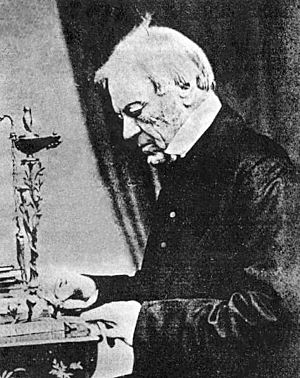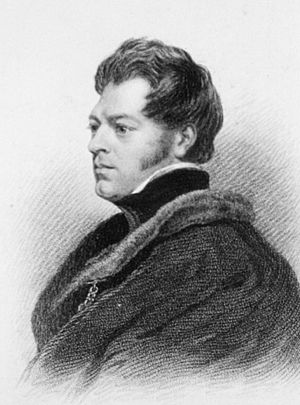John Richardson (naturalist) facts for kids
Quick facts for kids
John Richardson
|
|
|---|---|
 |
|
| Born | 5 November 1787 Dumfries, Scotland
|
| Died | 5 June 1865 (aged 77) |
| Alma mater | Edinburgh University |
| Awards | Royal Medal (1856) |
| Scientific career | |
| Fields | |
| Author abbrev. (botany) | Richardson |

Sir John Richardson (born November 5, 1787 – died June 5, 1865) was a Scottish naval surgeon, a naturalist, and an Arctic explorer. He was known for his journeys to the Arctic and his important work studying animals and plants found there.
Contents
Life
John Richardson was born in Dumfries, Scotland. His father, Gabriel Richardson, was the Provost of Dumfries. John went to Dumfries Grammar School. Later, he trained to be a surgeon with his uncle, Dr. James Mundell.
He studied medicine at Edinburgh University. In 1807, he became a surgeon in the navy. He joined John Franklin on an expedition to find the Northwest Passage. This journey, called the Coppermine Expedition of 1819–1822, explored parts of the Arctic. Richardson wrote about the rocks, plants, and fish they found during this trip.
Exploring the Mackenzie River
In 1825, Franklin and Richardson went back to Canada. They traveled by land using fur trade routes to the mouth of the Mackenzie River. Franklin explored west, while Richardson explored east towards the Coppermine River. Richardson had special boats that were better for the ocean than the canoes used before. He named a strait after his boats, called Dolphin and Union Strait.
His journey was a success. He reached his farthest point east on the same day Franklin reached his farthest point west. This was on August 16, 1826. He left his boats at Bloody Falls and walked to Fort Franklin. He arrived three weeks before Franklin. Together, they had mapped 1,878 miles (3,022 km) of coastline that no one had explored before.
Discoveries and Recognition
The discoveries of animals and plants on this expedition were so important that they needed two big books. One book, Flora Boreali-Americana, was about plants. The other, Fauna Boreali-Americana, was about animals. Richardson helped write the animal book.
In 1842, Richardson described a special diving suit and how a diver was treated after an injury. This happened during efforts to save parts of a ship called HMS Royal George.
Queen Victoria made him a knight in 1846. This meant he was given the title "Sir." He also joined John Rae on another trip to the Arctic in 1848–49. They were looking for Franklin, but they did not find him. Richardson wrote a book about this journey called An Arctic Searching Expedition.
He retired in 1855 and moved to the Lake District. Sir John Richardson died at his home on June 5, 1865. He is buried at St Oswald's Church, Grasmere.
Family
Sir John Richardson was married three times. His first wife was Mary Stiven, whom he married in 1818. In 1833, he married Mary Booth. His last wife was Mary Fletcher, whom he married in 1847.
Works
Sir John Richardson wrote many books and reports. Many of his writings focused on the natural history of the Arctic. He was especially interested in fish. Some of his important books include Icones Piscium (1843) and Catalogue of Apodal Fish in the British Museum (1856). He also updated a book called History of British Fishes in 1860. His book The Polar Regions (1861) shared his knowledge of the Arctic.
Taxon Named in His Honor
Many animals and plants have been named after Sir John Richardson. This is a way to honor his important work in natural history.
Reptiles
Four types of reptiles have his name in their scientific names:
- Eremiascincus richardsonii
- Hemidactylus richardsonii
- Myron richardsonii
- Sphaerodactylus richardsonii
Mammals
Some mammal species also carry his name:
- The Ermine, Mustela richardsonii
- The Ground Squirrel, Urocitellus richardsonii
- The Collared Lemming, Dicrostonyx richardsoni
Plants
A flowering plant is named after him:
- Boykinia richardsonii, also known as Richardson's brookfoam.
Fish
Two species of fish are named in his honor:
- Diaphus richardsoni (Tåning, 1932), a type of lanternfish found worldwide.
- Sardinella richardsoni (Richardson's sardinella), a type of sardine found in the South China Sea.
Taxon Described by Him
- See Category:Taxa named by John Richardson (naturalist)

